Africa Wild Insect Book: Moths (Lepidoptera)
Moderator: Klipspringer
AW Insect Book: Moths (Lepidoptera) Geometridae Sterrhinae
Sterrhinae is a subfamily of geometrid moths, placed in family Geometridae. The Sterrhinae are often referred to as 'waves' because of the narrow, uneven lines on their wings. They are mostly slender bodied, concolorous, pink or pale fawn, many species are white or yellow. Fine lines extend across the fore wing and continue across the hind wing. The discal spot is frequently present in both pairs of wings. Usaually smaller than the Ennominae. Sterrhinae tend to rest with the fore and hind wings slightly apart and with the wing edges flat on the substrate.
AW Insect Book: Moths (Lepidoptera) Geometridae Sterrhinae
Vestal Moth Rhodometra sacraria
Family: Geometridae. Subfamily: Sterrhinae. Tribe: Rhodometrini
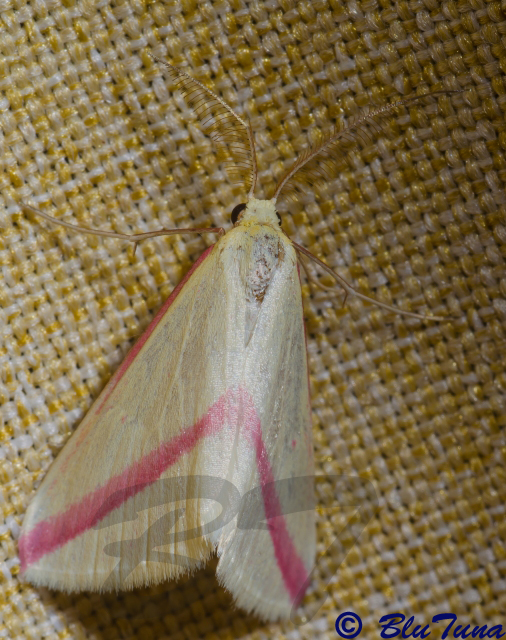 © BluTuna
© BluTuna
Garden in Johannesburg
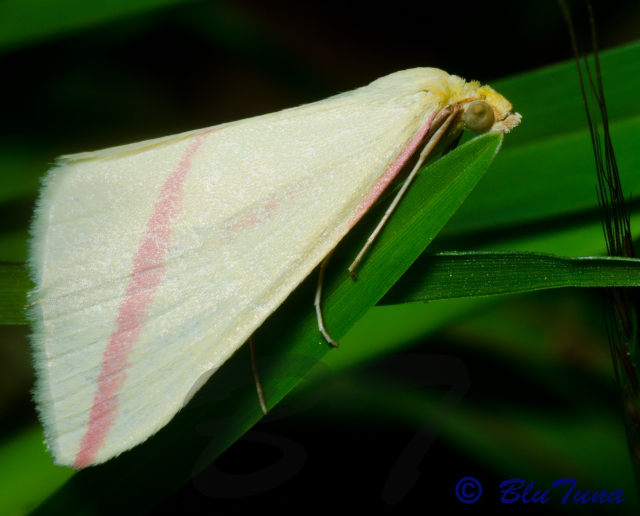 © BluTuna
© BluTuna
Garden in Johannesburg
Description
Rhodometra sacraria has a wingspan reaching 22–28 mm, while the length of the forewings is 12–14 mm. Head and thorax pale yellow. Forewing pale yellow to cream-coloured, hindwing shiny white. The forewing has a discal spot, and a distinct diagonal line, crossing diagonally the dorsal sides of the upperwings up to the apex. The dorsal sides of the hind wings are whitish. The intensity and the extent of the pink pigmentation is rather variable, depending on the seasonal temperature in the development of the pupae.
Usually the moths rest with a tent-like posture on twigs and herbs, with the wings parallel to each other.
The caterpillars mimic twigs and therefore they are quite difficult to locate. They are slender and reach a length of about 25 mm. The basic colour is pale brown or green, with a whitish underside. The green forms usually show a dark brown or reddish irregular stripe on the back. The head is reddish brown and relatively small.
Distribution
It is found throughout Europe, Africa (Algeria, DRCongo, Ethiopia, Kenya, Lesotho, La Reunion, Libya, Madagascar, Malawi, Morocco, Mozambique, Nigeria, South Africa, Tanzania, Tunisia, Uganda, Zambia, Zimbabwe) and large parts of Asia. A migraroty species. Found throughout South Africa.
Habitat
Common in grassland. This species inhabits meadows, forest clearing, paths, gardens and urban environments.
Biology
Larval foodplants: Anthemis, Emex, Oxygonum sinuatum, Persicaria, Polygonum, Rhus,
Links: African Moths
Family: Geometridae. Subfamily: Sterrhinae. Tribe: Rhodometrini
 © BluTuna
© BluTunaGarden in Johannesburg
 © BluTuna
© BluTunaGarden in Johannesburg
Description
Rhodometra sacraria has a wingspan reaching 22–28 mm, while the length of the forewings is 12–14 mm. Head and thorax pale yellow. Forewing pale yellow to cream-coloured, hindwing shiny white. The forewing has a discal spot, and a distinct diagonal line, crossing diagonally the dorsal sides of the upperwings up to the apex. The dorsal sides of the hind wings are whitish. The intensity and the extent of the pink pigmentation is rather variable, depending on the seasonal temperature in the development of the pupae.
Usually the moths rest with a tent-like posture on twigs and herbs, with the wings parallel to each other.
The caterpillars mimic twigs and therefore they are quite difficult to locate. They are slender and reach a length of about 25 mm. The basic colour is pale brown or green, with a whitish underside. The green forms usually show a dark brown or reddish irregular stripe on the back. The head is reddish brown and relatively small.
Distribution
It is found throughout Europe, Africa (Algeria, DRCongo, Ethiopia, Kenya, Lesotho, La Reunion, Libya, Madagascar, Malawi, Morocco, Mozambique, Nigeria, South Africa, Tanzania, Tunisia, Uganda, Zambia, Zimbabwe) and large parts of Asia. A migraroty species. Found throughout South Africa.
Habitat
Common in grassland. This species inhabits meadows, forest clearing, paths, gardens and urban environments.
Biology
Larval foodplants: Anthemis, Emex, Oxygonum sinuatum, Persicaria, Polygonum, Rhus,
Links: African Moths
Hunting cannot be considered a sport as all contestants in a sport should know they are playing the game!
AW Insect Book: Moths (Lepidoptera) Geometridae Sterrhinae
Geometer Moth sp., Looper Moth
Family: Geometridae. Subfamily: Sterrhinae
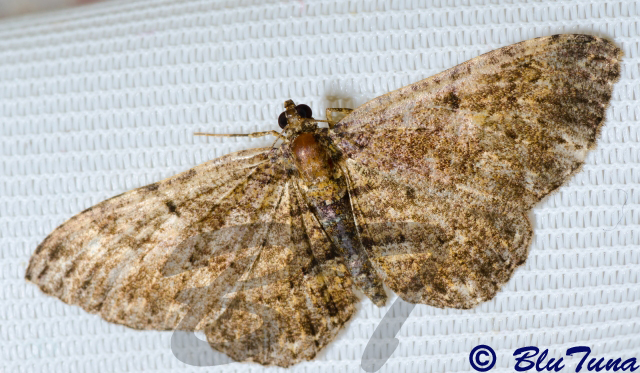 © BluTuna
© BluTuna
Garden in Johannesburg
Family: Geometridae. Subfamily: Sterrhinae
 © BluTuna
© BluTunaGarden in Johannesburg
Hunting cannot be considered a sport as all contestants in a sport should know they are playing the game!
Re: AW Insect Book: Moths (Lepidoptera) Crambidae
Family Crambidae (Grass Moths)
Moths in the family Crambidae are usually small, 15-25 mm. They are cream, pale yellow or streaked brown. Their long, projecting mouth parts give the appearance of a snout, so members of the family are sometimes called "snout moths." They have thin thread-like antennae, held backwards along the body at rest.
While resting, they roll their wings around their body so that their bodies appear angular. This makes them inconspicuous when they rest on stems or leaves.
The larvae are borers of stems or leaves.
Moths in the family Crambidae are usually small, 15-25 mm. They are cream, pale yellow or streaked brown. Their long, projecting mouth parts give the appearance of a snout, so members of the family are sometimes called "snout moths." They have thin thread-like antennae, held backwards along the body at rest.
While resting, they roll their wings around their body so that their bodies appear angular. This makes them inconspicuous when they rest on stems or leaves.
The larvae are borers of stems or leaves.
AW Insect Book: Moths (Lepidoptera) Crambidae Crambinae
Crambinae is a large subfamily of the lepidopteran family Crambidae, the crambid snout moths.
Links: African Moths
Links: African Moths
AW Insect Book: Moths (Lepidoptera) Crambidae Crambinae
Crambine Snout Moth Calamotropha sp.
Family: Crambidae. Subfamily: Crambinae
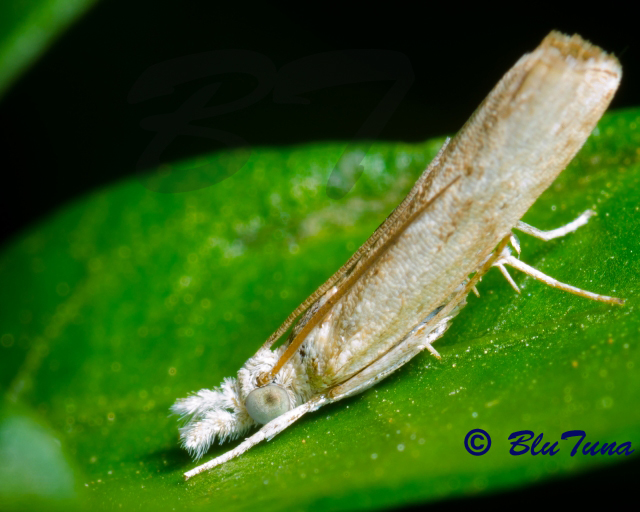 © BluTuna
© BluTuna
Garden in Johannesburg
Family: Crambidae. Subfamily: Crambinae
 © BluTuna
© BluTunaGarden in Johannesburg
Hunting cannot be considered a sport as all contestants in a sport should know they are playing the game!
Africa Wild Insect Book: Moths (Lepidoptera)
Subfamily Spilomelinae (Spilomenine Snout Moths)
Spilomelinae is a very large subfamily of the lepidopteran family Crambidae, the crambid snout moths. They were formerly included in the Pyraustinae as tribe Spilomelini; furthermore taxonomists' opinions differ as to the correct placement of the Crambidae, some authorities treating them as a subfamily (Crambinae) of the family Pyralidae. If this is done, Spilomelinae is usually treated as a separate subfamily within Pyralidae. The Spilomelinae are believed to be polyphyletic; many genera are only tentatively placed here even at this point.
With nearly 3,800 described species worldwide, this is the most speciose group among pyraloids. The moths are characterized by the absence of chaetosemata, a bilobed praecinctorium, projecting fornix tympani, pointed spinula, absence of a gnathos, and the female genitalia have no rhomboidal signum on the bursa copulatrix.
Links: African Moths - Spilomelinae
Spilomelinae is a very large subfamily of the lepidopteran family Crambidae, the crambid snout moths. They were formerly included in the Pyraustinae as tribe Spilomelini; furthermore taxonomists' opinions differ as to the correct placement of the Crambidae, some authorities treating them as a subfamily (Crambinae) of the family Pyralidae. If this is done, Spilomelinae is usually treated as a separate subfamily within Pyralidae. The Spilomelinae are believed to be polyphyletic; many genera are only tentatively placed here even at this point.
With nearly 3,800 described species worldwide, this is the most speciose group among pyraloids. The moths are characterized by the absence of chaetosemata, a bilobed praecinctorium, projecting fornix tympani, pointed spinula, absence of a gnathos, and the female genitalia have no rhomboidal signum on the bursa copulatrix.
Links: African Moths - Spilomelinae
Africa Wild Insect Book: Moths (Lepidoptera)
Measured Pearl Nausinoe geometralis
Family Crambidae. Subfamily Spilomelinae
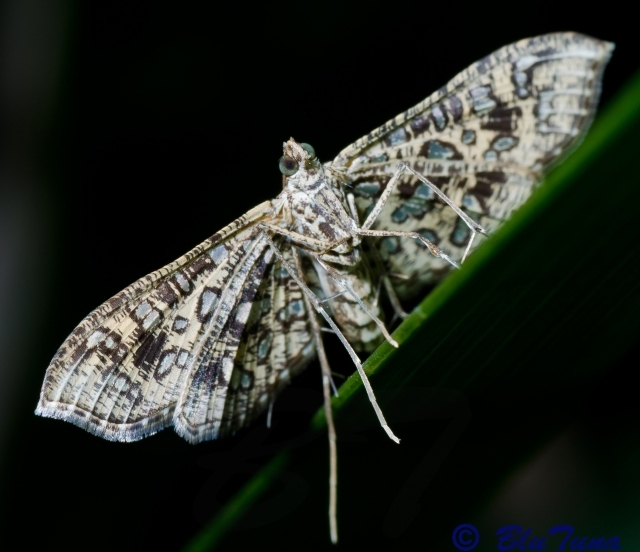 © BluTuna
© BluTuna
Garden in Johannesburg
Description
Wingspan: 23-25 mm. Antennae are longer than fore wing & almost simple. Head, thorax, abdomen and wings are yellow, striated with black. Fore wing with two black-edged antemedial white spots below the cell; a spot at middle of cell and another at end of it; a larger spot below origin of vein 2; a small spot above vein 2 and large spot above vein 5; a submarginal line from below costa to vein 5, with another below it nearer the margin and extending down to vein 3; a large reniform spot near outer angle. Hind wing with subbasal white band; an antemedial spot between cell and inner margin; a large spot beyond the cell; a submarginal spot from vein 6 to 3; a spot further from the margin below vein 3 and another from vein 2 to anal angle.
Distribution
It can be found in western, eastern and southern Africa (South Africa, Zambia, Zimbabwe), and some islands of the Indian Ocean as well as in Australasia, Australia and India.
Links: African Moths
Family Crambidae. Subfamily Spilomelinae
 © BluTuna
© BluTunaGarden in Johannesburg
Description
Wingspan: 23-25 mm. Antennae are longer than fore wing & almost simple. Head, thorax, abdomen and wings are yellow, striated with black. Fore wing with two black-edged antemedial white spots below the cell; a spot at middle of cell and another at end of it; a larger spot below origin of vein 2; a small spot above vein 2 and large spot above vein 5; a submarginal line from below costa to vein 5, with another below it nearer the margin and extending down to vein 3; a large reniform spot near outer angle. Hind wing with subbasal white band; an antemedial spot between cell and inner margin; a large spot beyond the cell; a submarginal spot from vein 6 to 3; a spot further from the margin below vein 3 and another from vein 2 to anal angle.
Distribution
It can be found in western, eastern and southern Africa (South Africa, Zambia, Zimbabwe), and some islands of the Indian Ocean as well as in Australasia, Australia and India.
Links: African Moths
AW Insect Book: Moths (Lepidoptera) Crambidae
Beet Webworm, Banded Sable Spoladea recurvalis
Family Crambidae. Subfamily Spilomelinae
 © BluTuna
© BluTuna
Garden in Johannesburg
Description
Wingspan: 22–24 mm. The adult is dark with two incomplete white stripes on each forewing, and a complete one across each hindwing. Forewing dark brown or gray with broad white median band beginning at inner margin and terminating in "fish-hook" shape before reaching costa; broad white PM band beginning at costa and terminating part-way across wing, with three white spots beyond it; fringe of both wings with dark and light patches.
The larva is brownish-green, with sparse white hairs, and a brown head with black speckles.
Distribution
It is found worldwide, but mainly in the tropics. Cameroon, DRCongo, Equatorial Guinea, Ethiopia, Gambia, Kenya, La Reunion, Madagascar, Morocco, Mozambique, Namibia, Niger, Nigeria, Rwanda, Senegal, Sierra Leone, Somalia, South Africa, Sudan, Togo, Tanzania, Zambia, Zimbabwe.
Biology
Larvae are polyphageous. A common pest on various plants. The main host plant is amaranth.
The life cycle of Spoladea recurvalis is approximately three to four weeks, the egg stage takes three to four days, the larval stage, 12–15
days and the pupal stage, 8-11 days). The average longevity of female is 6 days and 3.5 days in males.The moths emerge usually in the early hours of the morning and copulation takes place one to two days after emergence. Males search for females in nuptial flights and after some time, the male rests near the female in a tail to tail position. As soon as mating starts both sexes cease movement and remain motionless until the act of pairing is completed. Copulation lasts for 10 to 15 minutes and oviposition commences one to two days after mating. Before oviposition, the female becomes restless and flies actively, settles on the under surface of a leaf, touches the surface with the tip of her abdomen and lays the eggs. The oviposition period varies from two to four days and up to 200 eggs are laid.
Links:
African Moths
http://dspace.nwu.ac.za/bitstream/handl ... sAllowed=y

Nelspruit © Richprins
Family Crambidae. Subfamily Spilomelinae
 © BluTuna
© BluTunaGarden in Johannesburg
Description
Wingspan: 22–24 mm. The adult is dark with two incomplete white stripes on each forewing, and a complete one across each hindwing. Forewing dark brown or gray with broad white median band beginning at inner margin and terminating in "fish-hook" shape before reaching costa; broad white PM band beginning at costa and terminating part-way across wing, with three white spots beyond it; fringe of both wings with dark and light patches.
The larva is brownish-green, with sparse white hairs, and a brown head with black speckles.
Distribution
It is found worldwide, but mainly in the tropics. Cameroon, DRCongo, Equatorial Guinea, Ethiopia, Gambia, Kenya, La Reunion, Madagascar, Morocco, Mozambique, Namibia, Niger, Nigeria, Rwanda, Senegal, Sierra Leone, Somalia, South Africa, Sudan, Togo, Tanzania, Zambia, Zimbabwe.
Biology
Larvae are polyphageous. A common pest on various plants. The main host plant is amaranth.
The life cycle of Spoladea recurvalis is approximately three to four weeks, the egg stage takes three to four days, the larval stage, 12–15
days and the pupal stage, 8-11 days). The average longevity of female is 6 days and 3.5 days in males.The moths emerge usually in the early hours of the morning and copulation takes place one to two days after emergence. Males search for females in nuptial flights and after some time, the male rests near the female in a tail to tail position. As soon as mating starts both sexes cease movement and remain motionless until the act of pairing is completed. Copulation lasts for 10 to 15 minutes and oviposition commences one to two days after mating. Before oviposition, the female becomes restless and flies actively, settles on the under surface of a leaf, touches the surface with the tip of her abdomen and lays the eggs. The oviposition period varies from two to four days and up to 200 eggs are laid.
Links:
African Moths
http://dspace.nwu.ac.za/bitstream/handl ... sAllowed=y
Nelspruit © Richprins
Africa Wild Insect Book: Moths (Lepidoptera)
Family Pyralidae (Pyralid Snout Moths)
Small to large moths, not all of which are easily recognizable in the field. Generally delicately built, with narrow fore wings and broad hind wings, both with short fringe of hairs. In many species wings are satiny and translucent. Adults look like they have a nose or snout. Antennae half body length, simple, thread-like.
Small to large moths, not all of which are easily recognizable in the field. Generally delicately built, with narrow fore wings and broad hind wings, both with short fringe of hairs. In many species wings are satiny and translucent. Adults look like they have a nose or snout. Antennae half body length, simple, thread-like.


